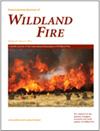将燃烧异质性与燃料负荷估算结合起来,可改善澳大利亚东南部桉树林的火灾行为预测
IF 2.9
3区 农林科学
Q1 FORESTRY
引用次数: 0
摘要
背景 火灾蔓延模拟对于实际火灾管理和战略风险规划至关重要。目的 量化火灾异质性对火灾后燃料负荷的影响,并检验根据上次火灾的严重程度和斑块程度修改燃料负荷估计值是否能提高后续火灾模拟的准确性。方法 我们(1)测量了澳大利亚东南部不同严重程度火灾后桉树林中的细小燃料;(2)根据我们的结果修改了火后燃料累积估算值;(3)对一个案例研究区域进行了不同的火灾模拟,该区域在计划的减灾燃烧后不久又发生了野火。主要结果 火灾严重程度的增加导致树皮燃料的减少。与此相反,在中度和高度火灾之后,地表和高处的燃料减少了相似的数量。考虑到燃烧异质性和火灾严重程度对树皮的影响,提高了案例研究中火灾蔓延的准确性。结论 将燃烧异质性纳入燃烧后燃料负荷估算可大大改善火灾行为预测。影响 如果不考虑燃烧异质性,严重程度较低的成片燃烧可能意味着风险估计不正确。这对评估计划燃烧方案的成本效益有影响。本文章由计算机程序翻译,如有差异,请以英文原文为准。
Incorporating burn heterogeneity with fuel load estimates may improve fire behaviour predictions in south-east Australian eucalypt forest
Background Simulations of fire spread are vital for operational fire management and strategic risk planning. Aims To quantify burn heterogeneity effects on post-fire fuel loads, and test whether modifying fuel load estimates based on the fire severity and patchiness of the last fire improves the accuracy of simulations of subsequent fires. Methods We (1) measured fine fuels in eucalypt forests in south-eastern Australia following fires of differing severity; (2) modified post-fire fuel accumulation estimates based on our results; and (3) ran different fire simulations for a case-study area which was subject to a planned hazard reduction burn followed by a wildfire shortly thereafter. Key results Increasing fire severity resulted in increased reduction in bark fuels. In contrast, surface and elevated fuels were reduced by similar amounts following both low-moderate and high-extreme fire severity. Accounting for burn heterogeneity, and fire severity effects on bark, improved the accuracy of fire spread for a case study fire. Conclusions Integration of burn heterogeneity into post-burn fuel load estimates may substantially improve fire behaviour predictions. Implications Without accounting for burn heterogeneity, patchy burns of low severity may mean that risk estimations are incorrect. This has implications for evaluating the cost-effectiveness of planned burn programmes.
求助全文
通过发布文献求助,成功后即可免费获取论文全文。
去求助
来源期刊
CiteScore
5.50
自引率
9.70%
发文量
67
审稿时长
12-24 weeks
期刊介绍:
International Journal of Wildland Fire publishes new and significant articles that advance basic and applied research concerning wildland fire. Published papers aim to assist in the understanding of the basic principles of fire as a process, its ecological impact at the stand level and the landscape level, modelling fire and its effects, as well as presenting information on how to effectively and efficiently manage fire. The journal has an international perspective, since wildland fire plays a major social, economic and ecological role around the globe.
The International Journal of Wildland Fire is published on behalf of the International Association of Wildland Fire.

 求助内容:
求助内容: 应助结果提醒方式:
应助结果提醒方式:


